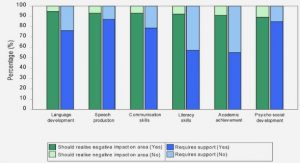Get Complete Project Material File(s) Now! »
Research Background
Abusive supervision is defined as “subordinates’ perceptions of the extent to which supervisors engage in the sustained display of hostile verbal and nonverbal behaviors, excluding physical contact” (Tepper, 2000, p. 178). Abusive supervision is a distressing problem for individuals and organisations, with workplace aggression impacting 13.6% of United States of America employees (Schat, Frone, & Kelloway, 2006). It is estimated that the cost of abusive supervision in the United States of America alone amounts to an approximate $24 billion per year, taking into account absenteeism, health care costs, and lost productivity (Tepper, Henle, Lambert, Giacalone, & Duffy, 2008).
There has been a growing interest in understanding the causes and consequences of negative leadership, i.e., corporate psychopathy (Mathieu & Babiak, 2016), petty tyranny (Ashforth, 1994), destructive leadership (Einarsen, Aasland, & Skogstad, 2007), workplace bullying (Hoel, Glasø, Hetland, Cooper, & Einarsen, 2009) and revenge (Bies, Tripp, & Kramer, 1997). In this study, I will focus on one type of negative leadership, abusive supervision. Abusive supervision differs from conceptually overlapping deviance-related constructs such as manager bullying and undermining in that the intentions of the manager are not important, but rather the perceptions of the employee1 (Martinko, Harvey, Brees, & Mackey, 2013).
As defined, abusive supervision is an employee’s perception of the extent to which his or her manager engages in the sustained display of hostile verbal and nonverbal behaviours, excluding physical contact (Tepper, 2000). These abusive behaviours include ridiculing, putting employees down in the presence of others, failing to give credit where credit is due, being rude and lying to employees. Numerous studies have explored the adverse consequences of abusive supervision. A metaanalysis conducted in 2015 found relationships between abusive supervision and numerous organisational and personal outcomes, such as decreased task performance, reduced job satisfaction, emotional exhaustion, work-to-family conflict, workplace deviance and reduced organisational commitment (Mackey, Frieder, Brees, & Martinko, 2015).
The majority of the research has focused on the detrimental consequences of abusive supervision. The predictors of abusive supervision have only been sporadically investigated. Of the twenty-two studies included in Tepper’s review of abusive supervision in organisations in 2007, only three involved predictors of abusive supervision. The predictors studied encompass managers’ procedural justice perceptions (Tepper, Duffy, Henle, & Lambert, 2006), managers’ perceived psychological contract violation (Hoobler & Brass, 2006), and managers’ perceptions of interactional justice and their authoritarianism (Aryee, Chen, Sun, & Debrah, 2007). Since Tepper’s (2007) call for further research in understanding antecedents of abusive supervision, there has been an increase in research in this area.
Martinko et al. (2013) list several new studies that have examined supervisor-related antecedents to abusive supervision, including stress and a lack of physical exercise (Burton, Hoobler, & Scheuer, 2012), co-worker conflict (Harris, Harvey, & Kacmar, 2011), deep-level dissimilarity (Tepper, Moss, & Duffy, 2011), emotional intelligence (Xiaqi, Kun, Chongsen, & Sufang, 2012), and histories of family undermining (Kiewitz et al., 2012). In their review on abusive supervision research, Tepper, Simon and Park (2017) further highlighted supervisor-related antecedents that have been explored in relation to abusive supervision, including supervisors’ psychological entitlement (Whitman, Halbesleben, & Shanine, 2013) and supervisors’ Machiavellianism through an authoritarian leadership style (Kiazad, Restubog, Zagenczyk, Kiewitz, & Tang, 2010). Subordinate-level antecedents that have been studied include subordinates’ negative affectivity (Tepper et al., 2006), subordinates’ lower performance (Liang, Lian, Brown, Ferris, Hanig & Keeping, 2016; Tepper et al., 2011), subordinates’ unfavourable response to supervisors’ attempts at charismatic leadership behaviours (Pundt, 2014), subordinates’ core self-evaluations (Neves, 2014), and high performing subordinates of supervisors who are high in self-dominance due to threats to organisational hierarchy (Khan, Moss, Quratulain, & Hameed, 2016).
TABLE OF CONTENTS :
- 1 INTRODUCTION
- 1.1 Research Background
- 1.2 Theoretical Model
- 1.3 Research Objectives
- 1.4 Summary of Research Questions
- 1.5 Importance and Benefits of the Proposed Study
- 2 THEORETICAL MODEL, LITERATURE REVIEW AND HYPOTHESES
- 2.1 Background
- 2.2 Theoretical Framework
- 2.2.1 Social Identity Theory
- 2.2.2 Linking Social Identity Theory with Implicit Bias
- 2.2.3 Definitions of Key Terms
- 2.3 Implicit Bias, Microaggressions and Abusive Supervision
- 2.3.1 Dual-process Theory of Implicit Bias
- 2.3.2 Implicit Bias and its Manifestation in Behaviour
- 2.3.3 Moderating Factors of the Relationship Between Implicit Racial and
- Religious Bias and Microaggressions
- 2.3.4 Moderating Factors of the Relationship Between Microaggressions and
- Abusive Supervision
- 2.4 Psychological and Behavioural Consequences
- 2.4.1 Consequences of Abusive Supervision
- 2.4.2 Moderating Factor of the Relationship Between Abusive Supervision and
- its Consequences
- 3 RESEARCH METHODOLOGY
- 3.1 Research Design
- 3.2 Target Population and Sample Method
- 3.3 Data Collection and Measurement Scales
- 3.3.1 Data Collection
- 3.3.2 Demographic Information
- 3.3.3 Measurement Scales: Employee Survey
- 3.3.4 Measurement Scales: Manager Survey
- 3.4 Data Analysis Strategy
- 3.4.1 Measurement of Abusive Supervision in South Africa
- 3.4.2 Hypotheses Testing
- 3.5 Research Ethics
- 4. RESULTS
- 4.1 Measurement Models
- 4.1.1. Model 1: The Employee-Rated Manager Behaviour Variables
- 4.1.2. Model 2: The Employee Self-Reported Individual Differences
- 4.1.3. Model 3: A Manager Self-Reported Individual Difference
- 4.1.4. Model 4: The Employee Outcomes
- 4.2 Descriptive Statistics and Correlations
- 4.3 Measurement of Abusive Supervision in South Africa
- 4.4 Hypotheses Testing
- 4.5 Summary of Results
- 5. DISCUSSION
- 5.1 Abusive Supervision and Racial and Religious Bias
- 5.1.1 Racial Bias
- 5.1.2 Religious Bias
- 5.2 Positive Manager Behaviour, Bias and Microaggressions
- 5.2.1 Self-monitoring
- 5.2.2 Individualised Consideration
- 5.3 Microaggressions, Attribution Styles and Abusive Supervision
- 5.3.1 External Attribution Styles
- 5.3.2 Hostile Attribution Styles
- 5.4 Abusive Supervision and Employee Outcomes
- 5.5 Abusive Supervision, Psychological Capital and Employee Outcomes
- 5.6 Contributions to Theory and Literature
- 5.7 Practical Contributions
- 5.8 Limitations
- 5.9 Directions for Future Research
- 5.10 Conclusions
- References
GET THE COMPLETE PROJECT
LINKING MANAGER IMPLICIT RACIAL AND RELIGIOUS BIAS TO ABUSIVE SUPERVISION: CONSEQUENCES FOR DIVERSE EMPLOYEES






